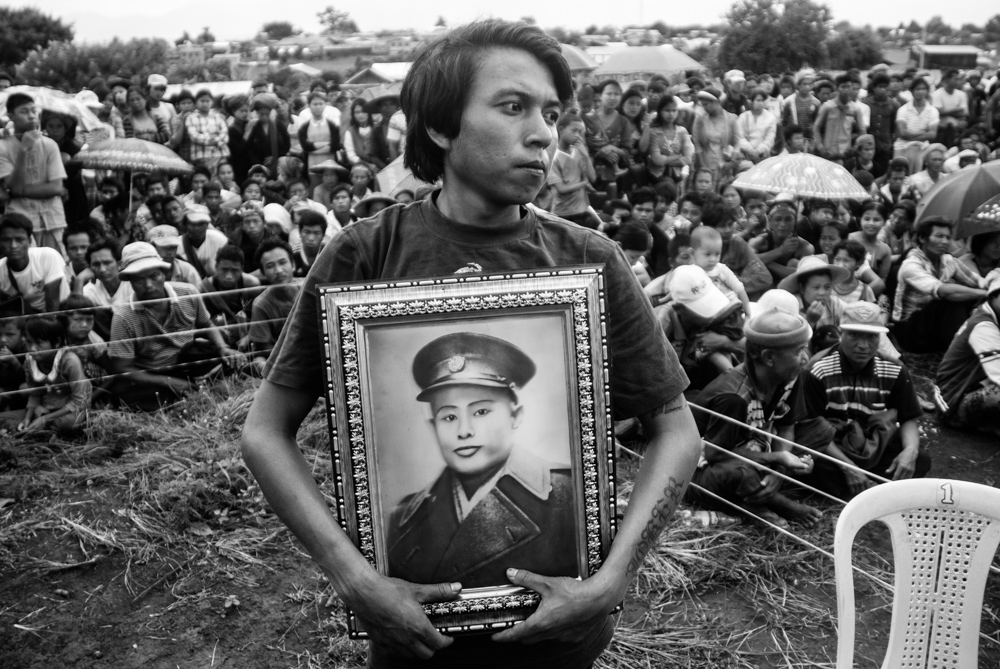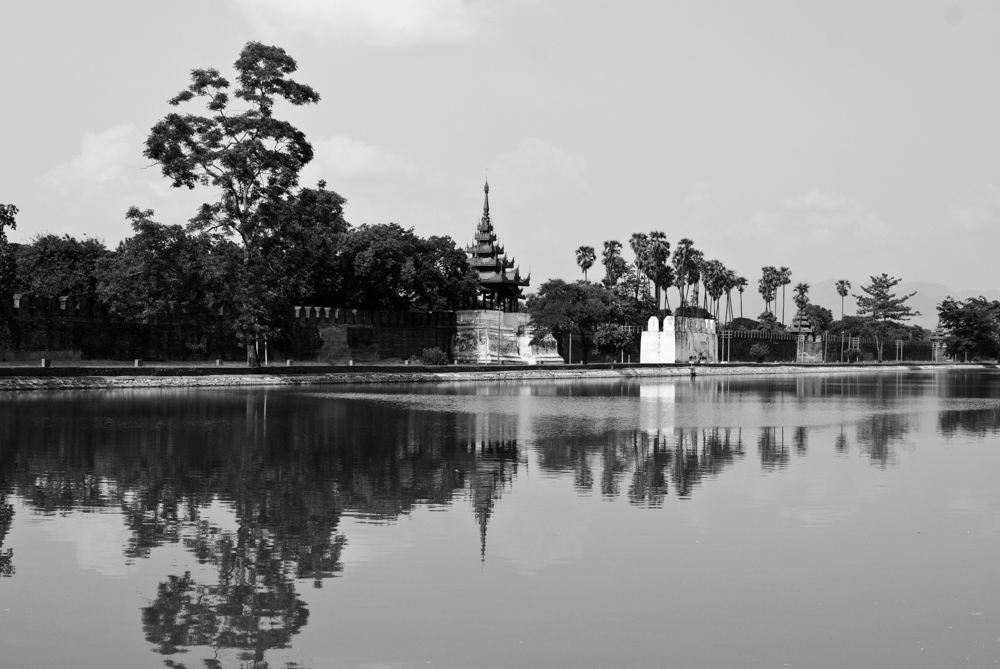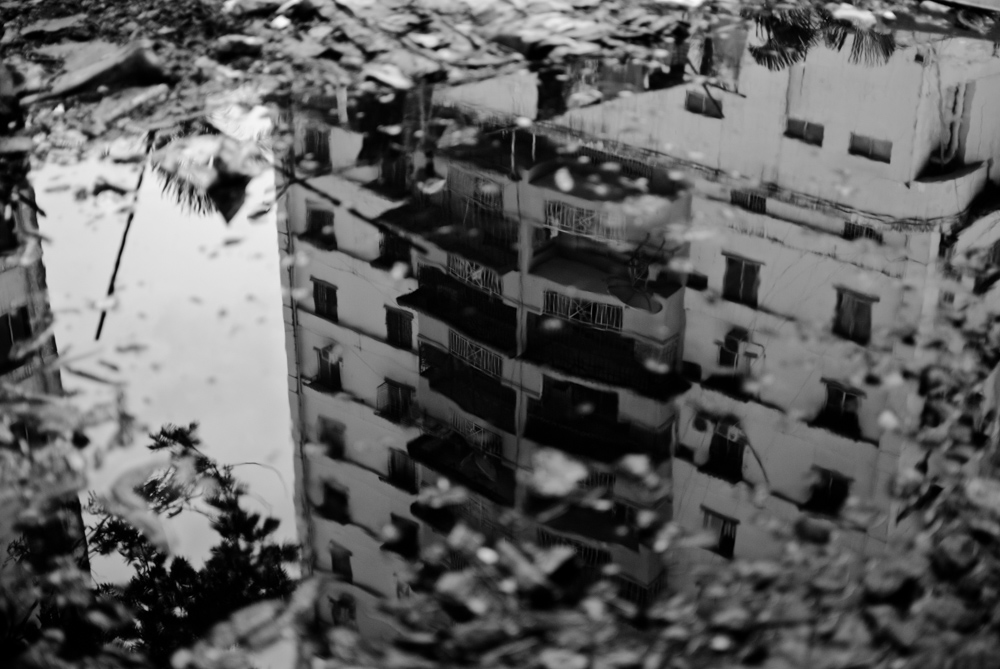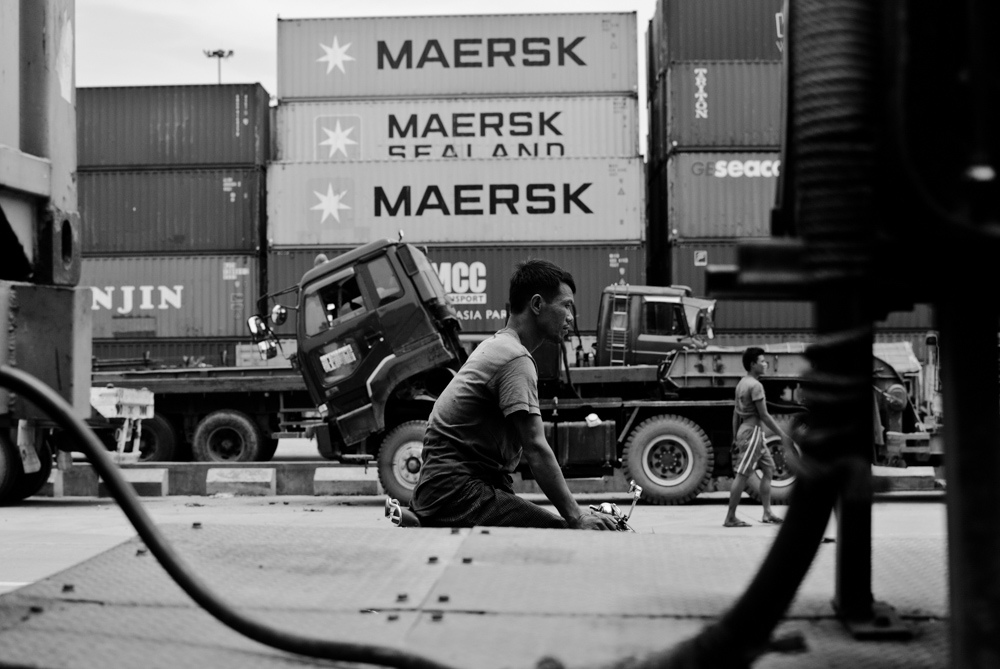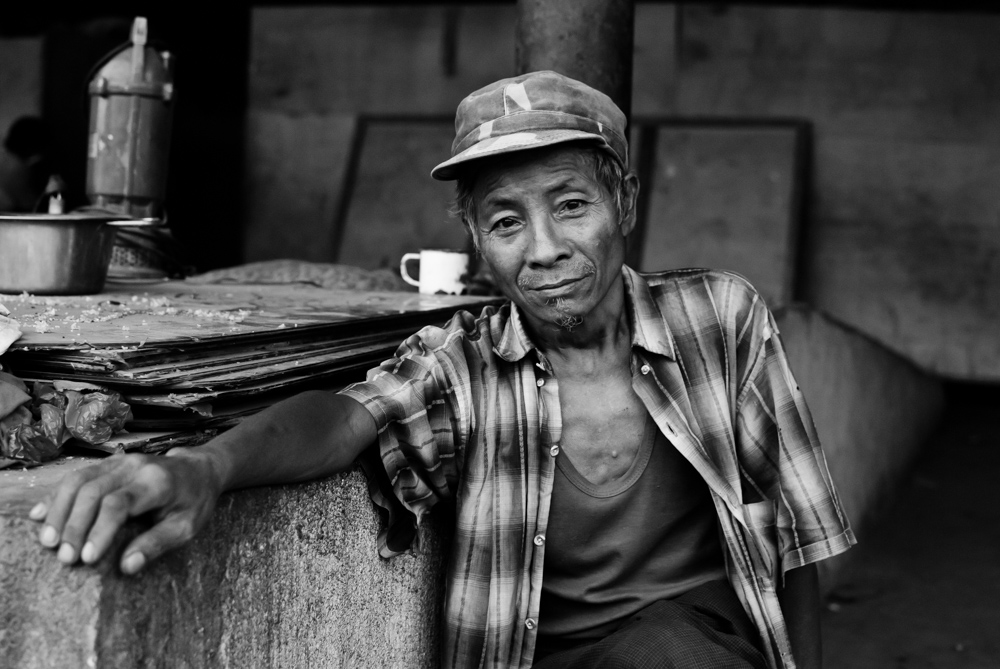On four new books that complicate the international image of Burma’s emergence from a half-century of military rule.
I.
THE NATION OF BURMA was born under a dark star. At 20 past four in the morning, on January 4, 1948 — the specific time was determined by astrologers — Burmese and British colonial troops assembled in the tropical gardens of the Secretariat, the headquarters of the colonial government in Rangoon. In a short ceremony, they ran down the Union Jack and hoisted in its place the new six-starred flag of independent Burma. As nearly a century of British rule came to a close, Burmese troops broke into patriotic anthems in their barracks.
Almost immediately, however, the country started to fall apart. In the east, ethnic Karen military units mutinied and turned their guns on the central government. Communist rebels rose up in the north, along the borders of soon-to-be Red China. In its first year, the new Republic of the Union of Burma came close to the brink of collapse. The Burmese military eventually succeeded in beating back the rebels, but ethnic conflict would persist around the country’s mountainous periphery, with profound implications for the subsequent development of the state. In March 1962, arguing that Burma’s squabbling politicians were unable to hold the country together, the military, or Tatmadaw, seized power in a coup, initiating more than half a century of military rule. Henceforth, military control and ethnic conflict would be mutually inflaming: heavy-handed army rule further fueled the desire of Burma’s various minority groups for self-determination; this, in turn, bolstered the Tatmadaw’s claim that it, and it alone, could prevent the country from flying apart.
The effects echoed through the second half of the 20th century. As regional neighbors like Thailand, Malaysia, and Singapore shot to prosperity in the 1960s and 1970s, Burma slumbered under the rule of General Ne Win, who led the 1962 coup and introduced what came to be known as the “Burmese Way to Socialism.” This fatidic doctrine had little to do with socialism in any meaningful sense. As a writer for the Far Eastern Economic Review was to note in 1974, its dominant characteristics — ethnic Burman chauvinism and economic autarky — were instead an exaggerated reaction to the humiliations of the British colonial period, when migrants and ethnic minority peoples had been empowered at the expense of the lowland Burman majority. Military rule and its pathologies, the writer concluded, were the reflex of a people who “remain victims of their history and ideological prisoners of their past reactions.” Astonishingly, things remained largely unchanged until the first decade of the 21st century.
When I first visited the old British capital Rangoon in 2009, the city seemed locked in an aspic of neglect. The pavements were cracked and covered with moss. Colonial-era dwellings sat in overgrown gardens, like apparitions out of Edgar Allan Poe. Everywhere the city was permeated by the same peculiar smell: a mix of betel quid, car exhaust, and wet-season damp. Dark, haunted Rangoon couldn’t have been further from the gleaming modernity of metropolises like Bangkok or Kuala Lumpur. Indeed, the city seemed to have changed little since the writer Paul Theroux had passed through in 1973, at the musty high noon of Ne Winism. The junta’s “notorious bureaucracy” — that was certainly unchanged, if the complaints of local people were any indication. So too the crowds passing along Sule Pagoda Road in the dilapidated downtown, the “men and women alike puffing thick green cheroots […] like a royal breed, strikingly handsome in this collapsing city, a race of dispossessed princes.”
And then there were the generals themselves. However deeply unpopular, Ne Win’s heirs still somehow clung to power despite successive waves of mass protests: most notably, in 1988, when anti-government demonstrations were drowned out with blood, forcing Ne Win’s resignation, and again in 2007, when Buddhist monks took to the streets in the so-called “Saffron Revolution.” By the time of my visit, Burma occupied a special category of international opprobrium. It was, like Iran and North Korea, a pariah-state.
As a slew of recent books recounts, however, the past five years have brought about a remarkable transformation of Burma’s international image. This was largely the result of economic and political reforms introduced by President Thein Sein, a slight, bookish general, who took office at the head of a new quasi-civilian administration in March 2011. The first sign of serious reform was the government’s September 2011 decision to cancel a controversial Chinese hydropower project in Kachin State in the north. Nearly overnight, stasis gave way to dizzying change. This was quickly followed by the release of hundreds of political prisoners and the abolition of Burma’s antique press censorship regime. In April 2012, Aung San Suu Kyi, Burma’s magnetic Nobel-Bodhisattva figure, was allowed to compete in by-elections that saw her National League for Democracy (NLD) sweep the field. Under near-constant house arrest until November 2010, “the Lady” was now elected to political office for the first time, and portraits of her appeared in public, like religious icons. Western governments rushed to endorse the changes, suspending or canceling the economic sanctions that had been imposed on Burma since the 1988 crackdown; thousands of aid workers, foreign investors, and tourists followed.
The reform-drive reached an ecstatic crescendo on November 8, 2015, when Burma went to the polls for a national election, the first freely contested poll for a quarter century. Despite some expectations that the military’s proxy, the Union Solidarity and Development Party (USDP), might find a way to preserve its governing majority, the people unambiguously voted for change. Suu Kyi’s NLD won a vast majority, just as it had the last election in 1990, when the Tatmadaw had annulled its victory and refused to give up power. This time, however, the military yielded. It seemed like the country’s stars were finally starting to realign.
II.
From a distance — particularly an American distance — it is tempting to see Burma’s transformation as a simple reversion to the democratic mean after decades of anomalous military rule. In her memoir Hard Choices (2014), former Secretary of State Hillary Clinton wrote at length about the role played by the United States in encouraging Burma’s opening. “While the Arab Spring was losing its luster in the Middle East, Burma was giving the world new hope that it is indeed possible to transition peacefully from dictatorship to democracy,” she wrote. This affirmed “the unique role the United States can and should play in the world as a champion of dignity and democracy.” Clinton offered a strong expression of what historian Timothy Snyder has termed “the politics of inevitability”: the intellectual tendency, ascendant after the Cold War, which sees liberal democracy and free markets as the Final Idea — something of a default position of humanity. In this view the arc of history, whatever its short-run deviations, always bends in the direction of justice.
In Blood, Dreams and Gold (2015), his refreshingly pessimistic account of Burma’s recent transformation, Richard Cockett argues that a troubled history is not so easily transcended. As he observes, many of the country’s conflicts have continued — even worsened — since the reforms. Nowhere is this reality starker than in situation facing Burma’s Muslim Rohingya minority. In 2012 and 2013, waves of violence broke out in coastal Arakan State in the west, where Buddhist Arakanese razed Rohingya neighborhoods, driving more than 120,000 into squalid displacement camps. The Rohingya have been refused citizenship by successive Burmese governments, including the new NLD administration, who assert they are all illegal “sneak-ins” from Bangladesh. This sentiment is inflamed by radical nationalists in the Buddhist sangha, who argue that a rising Muslim population threatens to swamp the country.
Things worsened in Arakan in mid-October, when the military was deployed in northern Arakan in response to coordinated attacks by militant Rohingya on police outposts. Since then the army has created a 7.7-square-mile “operation zone” in northern Arakan from which it has barred independent journalists and human rights workers. Despite the restrictions, reports have since emerged of rape, torture, and the extrajudicial killings of Rohingya civilians by soldiers and police, and a wave of arson attacks in the area that has destroyed around 1,250 buildings. Despite the real and significant improvements that have taken place in Burma since 2011, Cockett writes, “in important respects little has changed.”
Throughout his book, Cockett, a former Southeast Asia correspondent for The Economist, describes how Burmese leaders have failed, again and again, to reconcile monoethnic aspirations with multiethnic realities, and to turn Burma into a true “plural society.” The concept of the plural society was coined by the British colonial administrator-turned-scholar J. S. Furnivall, one of Burma’s first serious Western chroniclers. Furnivall, who lived in the country from 1902 until 1931, defined the plural society as one with a wide range of ethnic and religious groups “living side by side, but separately, within the same political unit.”
In Furnivall’s day, this accurately described the situation in freewheeling colonial port-cities like Rangoon, a “physical embodiment” of the imperial doctrine of free trade, where a wide range of creeds and ethnicities mingled in the marketplace. Fittingly, it is here that Cockett chooses to open his book, navigating down from the pinnacle of the city’s golden Shwedagon Pagoda into the old colonial downtown to the south. He effectively describes the still-bustling mercantile pluralism of the downtown, a gridded jumble of churches, mosques, temples, and imposing colonial edifices. He profiles its tiny Jewish and Armenian communities, shrunk now to handfuls of families, fading tinctures of the cosmopolitan brew created by British rule.
As Cockett points out, Furnivall didn’t exactly mean the “plural society” as a compliment. While it produced winners — including the waves of “bustling, ambitious migrants” who flocked to Burma’s cities from places like Nepal, Armenia, and Gujarat — there were many who lost out in the game of imperial mercantilism. Perhaps the central flaw of colonial Burma’s plural society was that it embraced pretty much everyone except the country’s ethnic majority, the Burmans, who made up some two-thirds of the population. As a result of British policy, Cockett writes, “The Burmans found themselves forced to the margins of their own towns, physically and culturally […] At best they were passive onlookers, at worst resentful victims.”
This resentment lies at the root of the fierce reaction that followed independence, and the fiercer one that followed the coup of 1962. Leaving aside his mismanagement of Burma’s economy, which did much to spark the 1988 protests, Ne Win’s worst legacy was to entrench a monocultural vision of Burmese identity, centered on its once-repressed Burman majority. Despite occasional nods to diversity, Cockett writes, the new government’s central thrust “was always towards ethnic, cultural, and religious homogeneity — to make Burman-ness a stand-in for an all-embracing national identity.”
The result of was an incoherent national selfhood which excluded, implicitly or explicitly, a full third of the country’s population. For Cockett, this is best symbolized by the junta’s 1989 decision to change the country’s English-language name from “Burma” to “Myanmar,” and to Burmanize dozens of ethnic minority place names. The Burmese monoculture has also been manifested in (literally) concrete form by the country’s showcase capital Naypyidaw, where the national government relocated in late 2005. The vast scale and geography of the new city, with its meandering, empty highways and towering statues of ancient Burmese heroes, stands in stark counterpoint to Rangoon’s multiethnic mix.
Cockett then turns his attention to the outlying parts of the country: the broken shards of Burma’s ethnic mosaic. He offers sketches of the Kachin, Shan, and Karen peoples and their continuing struggles for self-determination. Visiting Myitkyina, in Kachin State, he finds the capital of a militarized internal colony. He sojourns through the bizarre landlocked entrepôt of Mong La, part of an old Shan principality now controlled by an ethnic rebel army, which, under the terms of a ceasefire signed with the central government, has turned it into a seedy Chinese tourist colony of brothels and casinos. Cockett ends where he began, in Rangoon, arguing that unless the country embraces its extraordinary diversity, elections and further reforms will likely “only serve to disguise the country’s underlying divisions rather than resolve them.”
Tackling recent events from a different angle is Delphine Schrank, a former correspondent for the Washington Post. In The Rebel of Rangoon (2015), she provides the view from inside and below: from the perspectives of the Burmese activists who kept the flame of opposition burning in the years running up to the reforms of 2011. In a lush, novelistic narrative, Schrank introduces us to two members of this “band of hard-bitten oddballs and dreamers”: Nway, a young street-brawler-turned-activist for the NLD, and Nigel, his friend and rival.
Through the eyes of these two activist Everymen, we are immersed in the milieu of the Burmese underground. We follow them from moldy safe-houses to the dank cells of Insein Prison, where activists underwent grueling tortures, and dimly lit internet cafes, where they fired off furtive bleeps to the outside world. We witness the distribution of samizdat and hear the black humor of the activists, armor against the seeming uselessness of the cause, in part “because the jokes […] were mostly on them.” In places Schrank’s technique overreaches, and the narrative loses itself in long, descriptive thickets. But for the occasional mushiness of the prose, the reader is left with a vivid sense of what motivated ordinary people to oppose the military government, and the accretion of small frustrations that could tip a law-abiding citizen like Nigel — for whom politics previously “brought nothing but trouble” — into open dissidence.
Schrank depicts the dissident community as an extended family, with all the affection and rivalry that the term implies. At the top, a mostly disembodied absence in the narrative, is Daw — “Auntie” — Aung San Suu Kyi, a talisman to the young activists. Sketched in clearer lines is “Grandpa” Win Tin, the crusading journalist who is released from prison in 2008 and takes Nway under his wing. A hard-bitten sage, he refuses to swallow the bait of scant or partial reform. “People say we can see the light at the end of the tunnel,” he says after the 2012 by-election, “but we are still in the tunnel.” (Right up to his death in 2014, Win Tin continued to wear his prison blues, refusing to remove them until the country’s last political prisoner was freed.) Then there are the “Uncles,” members of the 1988 generation of student activists, tempered by prison, but ready nonetheless to thrust wedges into the chinks of freedom.
By telling her story from the perspectives of Nway and Nigel, Schrank is able to give an impressionistic rendering of the junta’s “villainous absurdity”: its bizarre blend of extreme paranoia and extreme incompetence. In a memorable scene early in the book, Nway, tailed home from the NLD office one evening by a Special Branch intelligence operative, ducks into a beer garden and phones in a dozen friends, who then proceed to out-wait — and out-drink — the lurking spooks, before splitting into the night.
Like Cockett, Schrank recognizes that for all the bravery of the men and women she describes, right up to Suu Kyi herself, military rule is not just a cause of Burma’s problems, but also a symptom. As the activists realize, “it would never be enough to simply replace the military junta with parliamentary democracy without simultaneously addressing the grievances of the minority groups.” This becomes clear after the 2012 by-elections, when Nigel is elected to parliament for the NLD. As the underground emerges into the light, the hard lines of opposition blur. “There were no easy answers,” Schrank writes, paraphrasing her Everymen. “There was no sense of arrival.”
III.
If anyone promised Burma deliverance, it was “Auntie.” Born in 1945, Suu Kyi was the youngest daughter of General Aung San, the storied independence leader — half Gandhi, half Subhas Chandra Bose — assassinated in July 1947, in the dying months of British rule. As a young woman Suu Kyi enjoyed a cosmopolitan upbringing. In the early 1960s, she studied in New Delhi, where her mother served as Burma’s ambassador to India, and later read P. P. E. at Oxford, where she met and fell in love with Michael Aris, a scholar of Tibet. After a few years working at the United Nations in New York, Suu Kyi returned to Oxford to raise her and Aris’s two children. Life for the couple unfolded in quiet domesticity until August 1988, when Suu Kyi paid a visit to Rangoon to tend to her ill mother and became drawn into the protests then roiling the city. On August 26, Aung San’s daughter addressed a mass rally in front of the Shwedagon Pagoda, and issued an electrifying call for democratic government.
The rest, as they say, is history — or perhaps more accurately, myth. If Burma’s recent developments have been seen by Hillary Clinton and others as an example of history’s universal, democratizing thrust, Suu Kyi’s has sometimes taken the form of a fairy tale. Its moral lines are drawn stark and clean: the beautiful daughter of an assassinated national hero opposes the gang of tyrannical generals who have driven their country into poverty and stagnation. Despite being cruelly condemned to house arrest, she becomes a world-famous tribune of democratic values, is garlanded by the Nobel Committee, and inspires a boycott campaign that casts Burma out of civilized international company. Eventually, the generals bow to the popular will and announce democratic elections. The Lady wins in a landslide and takes her rightful place as the country’s democratically elected leader.
Even before her party’s ringing victory in the 2015 election, however, the narrative has grown muddy. After five years of reforms, Burma’s former leaders had successfully remolded their country’s image while giving up relatively little real power. Enshrined in the junta’s 2003 “Roadmap to Discipline-Flourishing Democracy,” President Thein Sein’s tweaks represented not a capitulation but an orderly withdrawal to the battlements of the 2008 Constitution. This guarantees the Tatmadaw a quarter of the seats in parliament, and thus a de facto veto on any amendments, which require a 75 percent vote. It also bars Suu Kyi from the office of president, due to her marriage to a foreigner. (Instead, she serves now as “state counsellor.”) As Peter Popham writes in The Lady and the Generals: Aung San Suu Kyi and Burma’s Struggle for Freedom (2016), Suu Kyi’s entry into parliament in 2012 was a great victory, but one that dulled her insurrectionary edge. By luring her out of house arrest and into active politics, the army effectively bottled her up.
Popham’s book offers a breezy précis of the years since Suu Kyi’s release in 2010. In places, it shows signs of having been prepared quickly, and seems to have been padded with previously published material, some of only tangential relevance to the main narrative. The reader is sidelined by a chapter detailing the attempts of a band of British treasure-hunters to locate a rumored cache of Spitfire aircraft buried in Burma during World War II. Also included is a bizarre and contradictory piece of reporting from remote Chin State, in which Popham can’t decide whether to lament the loss of Chin traditions, or to romanticize the fact that they have persisted for so long. Immodestly, he boasts of being “among the first foreigners to travel to Burma’s Chin state in more than half a century.”
Popham is at his best when discussing the theory and practice of Suu Kyi, the subject of his 2011 biography The Lady and the Peacock. He writes that the myth of “The Lady” arose in an absence. Confined by the junta to her family’s crumbling home on Rangoon’s Inya Lake, with only fleeting connections to the outside world, Suu Kyi became an outsized figure, the vehicle for a wide range of often contradictory hopes and imaginings. The paradox was that when she was finally released in 2010, Burma’s towering democratic icon, a woman feted around the world as her country’s legitimate leader, “was as close to being a political virgin as any world-famous political leader has ever been.” Though armed with an iron will, she was unschooled in the arts of barter and compromise, and unable to negotiate the constitutional booby-traps strewn along the junta’s road to “Discipline-Flourishing Democracy.”
While acknowledging the huge sacrifices she has made for her country, Popham pours acid on the fairy tale and its subject. In the course of the book, he describes Suu Kyi’s transition from “girlish gaucheness” through “precious upper-class hauteur” to “a ravenous egotism that perhaps the years of isolation only made worse.” Like many others, Popham rightly lashes Suu Kyi for not speaking out about the repression of the Rohingya, something that he puts down both to political calculations — not wishing to alienate her anti-Muslim support base — and to her “complex and ambivalent feelings about the Burmese army,” in whose founding in 1945 her father played a key part.
Ultimately, Suu Kyi’s dissonant attitude toward the Rohingya raises important questions about how we fashion political idols, and for what ends. It calls to mind Orwell’s dictum that saints “should always be judged guilty until they are proved innocent.” It’s a pertinent suggestion in the case of “The Lady.” Orwell made this observation in his essay “Reflections on Gandhi” (1949), in which he eventually ruled, almost reluctantly, in favor of the Mahatma. While “one may reject the claims of sainthood made on his behalf,” Orwell wrote — and he himself admitted “a sort of aesthetic distaste” for the Indian leader’s calculated humility and “medievalist” program — Gandhi could ultimately claim a positive political legacy. “Compared with the other leading political figures of our time, how clean a smell he has managed to leave behind!”
Since the end of her house arrest, Suu Kyi has repeatedly claimed that she is not an icon, but a politician. She is right that she never claimed the mantle of sainthood, which was instead thrust upon her, as with Gandhi, by supporters at home and abroad. But when the time comes to render a verdict on Suu Kyi, the politician, the following fact must be entered into evidence: despite her huge reserves of political capital, and the fact that control of the army remains largely out of her grasp, Burma’s Nobel Peace laureate has said little, and has done less, to end the repression of the Rohingya. When pressed, Suu Kyi has instead taken refuge in NGO-speak, calling for the “rule of law” to be respected in Arakan State. Leave aside the question of whether the laws on the books, such as the 1982 law barring the Rohingya from citizenship, are just; in a country which has never known truly independent courts, calling for the “rule of law” is tantamount to calling for everything — and therefore for nothing at all.
IV.
What, then, is to be done? U Kyaw Win, a Burmese exile now living in the United States, writes that a lasting solution to Burma’s problems can only come from deep introspection. Introspection is the keynote of My Conscience: An Exile’s Memoir of Burma (2016), in which the octogenarian Win offers an elegy to the country he once knew, and the country it might have been. As a Burman who is old enough to remember hearing the troops singing at the dawn of independence — one of the many interesting recollections that scatter this personal volume — he is well placed to anatomize the ethnic chauvinism that lies deep in the country’s heart. One of the most refreshing elements of his book is that Win remains immune from the anti-Muslim sentiments that infect even some Burmese activist circles. Pondering the plight of the Rohingya, Win poses the obvious moral question: “How can we remain indifferent to such an assault on human dignity?”
Born in 1934, Win was not a typical exile. He left Burma to teach in the United States in 1961, “not with the intention of staying away permanently, but because I was denied the change to put to best use the education and experiences I had acquired abroad to benefit my fledgling country.” His citizenship revoked, Win started thinking, writing, and acting against Ne Win’s junta — his “nemesis” — long before it became an international cause célèbre. When he organized his first protest at the US Capitol in the summer of 1975, just four other people attended. In 1973, Win established the activist Burma Bulletin, “just to say something” about affairs in his country, and produced it for 19 years in the United States. Later, he helped establish the Foundation for Democracy in Burma, and became a familiar face in the refugee camps and exile entrepôts along the Thai–Burmese border. Looking back, from the remove of exile and advanced age, he acknowledges the difficulties of slowing the weighty inertia of Burmese history.
Kyaw Win offers no grand solutions to his country’s problems, merely some humble gestures. He suggests that the government rebuild the Rangoon University Student Union building, dynamited by Ne Win’s troops while putting down post-coup protests in 1962, as a monument to those men and women who have nudged their country toward a more democratic future. He also calls for the repatriation from India of the remains of King Thibaw, Burma’s last monarch, exiled by the British after his defeat in the Third Anglo-Burmese War of 1885, whose tomb lies neglected on the outskirts of the coastal city of Ratnagiri, in Maharashtra. This symbolic act would “unburden the present and future generations of Burmans, if not all Burmese, to know that their last sovereign, exiled to foreign turf, has finally been brought home to rest in eternal repose.” It could even take the form of a “royal swap”: after the Indian Rebellion of 1857, the last Mughal emperor, Bahadur Shah Zafar, was banished to Rangoon, where his tomb remains.
Win admits that these would be quixotic gestures, merely the “first steps in a long journey.” But they pinpoint Burma’s need not simply to introduce technical reforms, but also to somehow excavate and set on new foundations the myth of the country’s founding. Like the nobleman Cassius in Julius Caesar, Kyaw Win writes that fault lies not in Burma’s stars, but in the acts of its leaders, especially its Burmans, who took it as “their right, if not their destiny, to rule over others.” His rays of humanity serve to illuminate the scale of the challenge.
Published by the Los Angeles Review of Books, January 1, 2017


